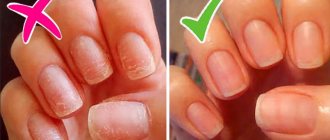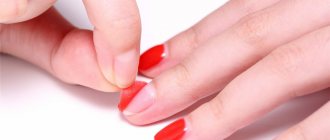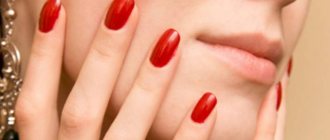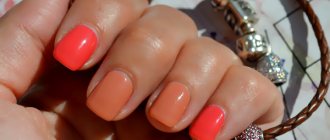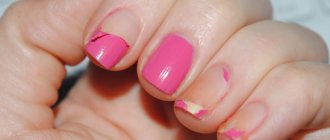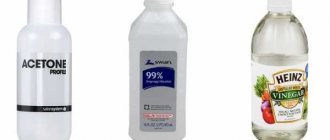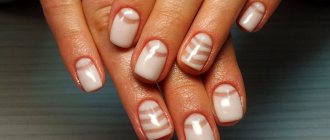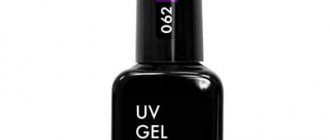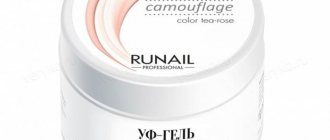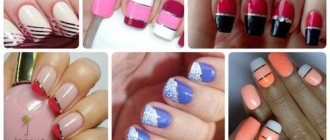How long will gel polish last? The gel coating looks impressive and does not react to environmental influences.
Due to the fear of a short-term effect, many women are interested in how long gel polish lasts and how to extend its wearing period? The condition of the nail plates, the quality of the material and application conditions affect how long the gel polish will last on your hands. It contains special substances that can ensure strong adhesion of the nail to the coating. How long a gel polish manicure will last depends on following the correct layering technology.
Harm of gel nail polish
The creation of gel polish at one time created a real sensation. Of course, women’s lives in terms of manicure have become much easier. At least in some segment of the beauty industry, beauty has ceased to require sacrifice. There is no need to paint your nails every day. Gel polish lasts for three weeks. You can also say goodbye to chipped nails. Beauty, variety of decor, convenience and durability. This is how gel polish won the love of women.
But experts do not recommend overusing even regular polish, let alone gel polish. Constantly wearing such a colored layer harms the nail plate, interferes with air exchange, and violates the nail’s own protective layer.
Some manicurists boast of their ability to apply gel polish under the cuticle. Why is this so valuable? Yes, because this way the manicure looks neat longer. The regrown part of the nail is not visible. This service is also called deep manicure. But it is not at all useful either for nails or for us. The fact is that with such manipulation the root of the nail is damaged. In the professional sphere, this place is called the matrix. As a result, longitudinal grooves may appear on the nails. Cracks may even appear at the base of the nail. You understand that such a defect will take a long time to grow.
Go ahead. We need the cuticle in order to protect the matrix from external influences. From dirt, infections, aggressive household chemicals and various mechanical damage. When a cuticle master pushes back, he, firstly, damages it. Secondly, all the unhealthy substances contained in the varnish are much more likely to enter your body. This procedure can damage the nail folds and cause inflammation.
Each gel polish has its own wear time. And the manufacturer must indicate it on the packaging. If, of course, he is conscientious and cares about his consumers. You don’t need to remove polish when your nails have grown long and started to look sloppy. And then, when the manufacturer indicated. Because after this period the polymer bonds in shellac disintegrate. Then such a manicure is not only unwearable, it is dangerous to health. When the polymer bonds of the varnish are destroyed, harmful components are released and enter our body. The result may be allergies or even bronchial asthma. Further, if you rewear the gel polish on your nails, the adhesion between the nail and the polish becomes stronger. It will be more difficult to remove. In this regard, the risk of nail damage increases.
How long does strengthening gel polish last?
The durability of gel polish is affected by the method of strengthening. Some nails are quite strong and hard by nature and have a good thickness. For them, conventional preparation using an acid-free primer and a plastic rubber base is sufficient. The coating wears well on these nails. Unfortunately, manicurists have few such clients. In most cases, due to a lack of vitamins and individual characteristics of the body, nails can be thin, and sometimes resemble rags or pieces of paper.
In this case, it is almost impossible to achieve durability of the coating for 2-3 weeks without using additional reinforcement. Soft nails, when covered with a layer of rubber base and gel polish, curl and bend, thereby causing cracks to form on the surface. As a result, the coating comes off in pieces or sheets. To prevent this from happening, it is recommended to reinforce it with a solid material.
Materials for strengthening the nail plate:
- Base with acrylic powder
- Self-leveling liquid gel
- Polygel
How long does strengthening gel polish last?
- The wearing period often exceeds 1 month. Strengthened nails do not bend, so the coating holds well.
- The choice of this or that material depends on the experience of the master and the characteristics of his hands. Sometimes the coating barely wears on wet hands with thin nails. In this case, it is recommended to cover the nails with a base layer, and lay gel on top of it, cutting out the natural nail from the inside, since it can cause detachments at the ends.
- This happens most often with thin nails that look like “napkins.” They are soft, bend and peel off from the back of the coating. As a result of this, the material chips at the ends.
Chips from the ends
Dangers to nails
The procedure for applying gel polish can adversely affect your health.
Effect of varnish
According to experts, daily painting with even ordinary varnish is extremely harmful. Prolonged wearing of the gel causes irreparable damage to the nail plate, since the coating prevents the penetration of oxygen . In addition to this, the nail is left without a top protective layer. Long-term wearing or use of a low-quality product can lead to negative consequences for the nail plate. It could be:
- yellow tint;
- uneven and bumpy surface;
- delamination;
- dull color;
- thinning;
- formation of cracks.
Drying in a UV lamp
Experts note the negative impact of UV lamps on human health when covering nails with a cosmetic product. However, due to the small amount of time the lamp is used, its negative effect is minimized.
Important! The exception is direct contraindications to the use of ultraviolet radiation, for example, cancer. In such cases, decorative coating using the device should be categorically abandoned.
Removing old coating
Removing gel polish with acetone has a negative effect on your nails. The product dries the skin and disrupts the nail structure . Constant inhalation of acetone vapor causes problems with the nervous system. Because of this harmful effect, craftsmen prefer to cut off the old gel with a special cutter.
Removing a manicure yourself can lead to injury to the nail plates.
How to apply gel polish correctly so that it lasts a long time
Gel-coated nails do not require additional strengthening and look natural. The gel coating lasts a long time, protects the nail plates from fungus, and also allows you to grow strong nails, preventing their splitting.
The procedure for applying professional material is similar to painting nails with regular varnish. The only difference is in the method of preparing the nail plates and drying the applied layers.
Important. Choosing a good master is the main step to creating beautiful and well-groomed nails for a long time. A professional manicurist uses only one brand of base, color and top coat.
The procedure for creating a manicure takes no more than an hour. Knowing its specific algorithm, you can control the master at all stages of work.
- Step 1.
Pre-treatment of nails and cuticles. To prepare the nail plates, masters mainly use unedged manicure, giving them the same shape. This is followed by grinding, degreasing and coating with a base product that improves the adhesion of the material to the nail. After applying the primer, you should not touch the top of the nail, as this will damage the thinnest layer of the base product.
- Step 2.
When applying a colored layer, the manicurist must be extremely careful. If the material gets on the cuticle area or skin, it will quickly cause the varnish layer to peel off from the nail plate. Each layer is applied evenly and then dried under a UV lamp.
- Step 3.
The top coat should be applied thinly. After applying the topcoat, the nail can no longer be filed or modeled.
Harm from gel polish: signs
There are some clear indicators that gel polish is harming you. They are visible to the naked eye:
- yellowing of one or more nails;
- the appearance of irregularities and bumps
- splitting of nails;
- dullness of the nail plate;
- thinning of the nail;
- the appearance of brittleness and cracks.
If you notice one, and even more so several, such signs in yourself, then you should at least wait a while with gel polish. It’s better to give it up completely. Because in addition to such cosmetic disadvantages, gel polish carries much more serious harm to the health of the entire body. More on this below.
How to determine the nail stress zone.
How long can you wear gel polish?
You already understand that on average it is advisable to wear a manicure for 2-3 weeks. But still people are different. How can you determine how long you can wear gel polish?
There is a simple test that gives a clear answer to this question.
- Remove the coating to leave your nails clean. Without any coverage at all.
- Press the free edge of the nail so that the part you pressed turns white
- The border between the pink and white parts of the nail will be the stress zone.
As a rule, the stress zone on clean nails is approximately in the middle of the nail, a little closer to the cuticle. Up to this very point you can wear the old coating and not update your manicure.
Every day the stress zone will move closer to the edge of the nail. As soon as it gets very close (in 2-3 weeks), you will have every chance of getting a crack, or even breaking your nail.
What happens if you wear gel polish for more than three weeks?
It all depends on your individual characteristics and the speed of nail growth. If your nails don't grow very quickly, then please. Can you wear gel polish for at least a month?
Is it possible to do shellac while pregnant?
It is not prohibited to apply gel polish to your nails during pregnancy. To protect yourself and your unborn baby, you need to listen to the advice of experts. If the recommendations are followed, the procedure will not cause any harm, but the following is required:
- Before coating, apply nourishing cream to your hands;
- make sure there is access to fresh air in the cabin;
- the manicure chair should be as comfortable as possible;
- Use only high-quality gel polish. A product that is dangerous to use can be identified by an unpleasant aroma and a bottle that does not have a label . The bottle must be numbered. If there is no license plate at the bottom of the bottle, it is better to refuse the procedure;
- do not get manicures from specialists who receive clients at home. You may have to deal with improper handling of instruments.
Composition of gel polish
The apparent advantages of varnish hide its main disadvantages and dangers. For shine, strength, smooth application and long-lasting wear of shellac, various chemicals are added to it. And the main harm of gel polish lies in its composition. Do not think that if the nail is hard, then it does not absorb anything and nothing gets into the body. This is a misconception. Everything is absorbed through the nail plate in the same way as through the skin.
So, gel polishes contain such harmful ingredients as:
| Ingredient | Harm |
| Toulol | a solvent used in paints and varnishes. And the fact that it is included in nail polishes and paints for various surfaces should already alert you... It is toxic if inhaled. It can cause problems with the kidneys, liver and bile ducts, and damage muscles. Irritates eyes, causing redness and dryness. Toulol vapor may adversely affect fetal development in pregnant women |
| Formaldehyde | Let's start with the fact that it is poison. And it's toxic. Harms the immune system, liver and can cause cancer. Contact with formaldehyde is strictly prohibited for pregnant women and asthmatics. It accumulates under the nails, dries them out and thins them. And phenol-formaldehyde resin can cause inflammatory skin lesions, allergies, and respiratory diseases |
| Triphenylphosphate | destroys the human endocrine system and proper metabolism. Harmful to the environment. Included in the list of prohibited ingredients |
| Dibutyl phthalate | adds plasticity to the varnish and makes the color more stable. Toxic. In general, all phthalates negatively affect the functioning of the thyroid gland and endocrine system. Harmful to skin and lungs |
| Waxy antioxidant butylated hydroxyanisole | harms the hormonal system |
| Ethyl tosylamide | has a medium hazard class, toxic. Harmful if inhaled |
| Butyl acetate, ethyl acetate | are used as solvents. Irritates mucous membranes of the throat and eyes. Prolonged inhalation of these vapors causes rapid breathing and decreased physical activity. Harmful to the central nervous system |
| Nitrocellulose | The base of the varnish serves to form a hard and even film on the nails. Also irritating to the respiratory system, toxic |
| Styrene copolymer acrylate | added to nail polish to form a waterproof film on nails. Harmful if inhaled. Irritating to skin and eyes. Not safe for the environment |
| N-butyl alcohol | may cause headaches, eye and respiratory tract irritation |
| Propylene glycol | preservative, causes skin irritation, can damage the functioning of the kidneys and liver. May cause cancer |
These are not all the harmful components of shellac; in fact, there are many more of them. The main thing is that they are all toxic and dangerous when inhaled, even in small doses. Well, if you breathe all this once every three weeks for several hours, then you are guaranteed to have health problems.
Want to know which polishes and gel polishes are safe to use? We conducted an expert assessment of more than 20 varnishes, identifying both safe products and products with critical ingredients. You can see some of these funds in the picture above. To find out more, go to ecoface.ru in the ECOTESTS section. Select the “Body” category and check the box next to the eco-test you need. Just 5 minutes and you get a ready-made table with ratings of manicure products for only 150 rubles.
Go to ecoface.ru
Differences between gel polish and shellac
Gel polish and shellac are very similar to each other. They combined the features of varnish (shine, wide range of light, ease of application) and gel, which gave these products special stability and eliminated unpleasant odors. To do this, while applying gel polish or shellac, you must keep your fingers under an ultraviolet lamp.
Moreover, each applied layer must be dried well: if it does not harden completely, the manicure will last only a couple of days, or even less (there is an option that you will have to repaint your nails after a few hours). Under the influence of the ultraviolet rays of the lamp, a reaction occurs during which the material is very tenaciously glued to the base. This allows it to remain on the nails until they grow so long that correction is necessary. Experts use several types of lamps:
- LED lamp that dries the varnish in forty seconds;
- A nine-watt ultraviolet lamp - depending on the stage of the procedure, it takes from one and a half to three minutes (according to reviews, a lamp of this power is relatively inexpensive and is well suited for home use);
- A 36-watt UV lamp is considered a professional model; it dries, like an LED lamp, in forty seconds, but unlike it, it takes up a lot of space.
The main difference between gel polish and shellac is the application method and the effect on the nail plate. The initial stage of preparation for the procedure is not much different: you need to push back the cuticle, remove the skin, degrease the surface, removing natural deposits (grease and dust). After this, when applying gel polish, you need to use a primer - this is the name of the liquid that provides better adhesion of the nail plate to the varnish.
At the same time, shellac does not require this, and it can be applied directly to the prepared nail. But this product has a disadvantage: it can only be applied to strong and healthy nails, since shellac greatly dries out the nail plate and contributes to its delamination.
Gel polish also has an aggressive effect on nails, although not as strongly as shellac, so when deciding to use these products, you must take into account that it will not last long on thin, constantly peeling nails. Before applying it, you first need to take measures to strengthen your nails, including taking a vitamin-mineral complex that contains biotin and silicon.
You should also include in your menu foods rich in calcium, vitamins A and E. These can be dairy products, vegetables, fruits, sunflower oil. And only when the nails become strong and healthy can shellac be applied to them.
Harm from manicure
Of course, the harm is not the finished manicure itself, but the manipulations that are used in the process of creating it. Not only gel polish can cause harm, but also an incorrectly and illiterately done manicure.
If the master does not follow the technique during the manicure procedure, he can damage the nerves located near the nail. Damage to the cuticle and resulting microtraumas are especially dangerous. The varnish applied to the nail penetrates them and enters the body through the blood vessels. Of course it's dangerous.
Among other things, there is a high risk of getting an infection. Nail technicians are not dermatologists, they do not understand fungi. They give manicures to everyone, without paying much attention to the condition of the client’s nails. And then they use the same tools to work with the next and next client. And it’s good if the master is responsible and disinfects the tools after each procedure. If not, then the fungus from the nails of the previous client will quite easily migrate to your nails.
And the lamp under which you dry your nails is also harmful. It provokes the appearance of skin cancer. A US publication called Archives of Dermatology conducted an interesting study in 2009. It concluded that systematic irradiation of the skin, even for 10 minutes, greatly increases the risk of skin cancer. And in 2012, the British Journal of Dermatology published information stating that several women developed cancer precisely because of manicure drying lamps.
Hyponychium is another reason to update the coating on time
Hyponychium is the skin under our nails. It protects the body from all kinds of infections and viruses when dirt gets under our nails.
Hyponychia can often “stick” to the bottom of the nail plate. If you walk around with gel polish for a long time, the nail grows a lot and pulls out this same hyponychium. And this is a piece of living skin for a moment. The next time you come with overgrown nails for a manicure, and the master starts to remove the length with a file, it will hurt. This is because, along with the nail, the master will file off this very piece of living skin. And there’s nothing you can do about it - just renew the coating in time, and don’t let the hyponychium grow too long.
How to stop wearing gel polish for longer than expected.
As an option, immediately after the next gel polish application, immediately make an appointment with the specialist for the next session. We professionals love it when clients do exactly this. You know in advance that in two to three weeks you are scheduled to visit a manicurist. Personally, I try to contact the client before the appointment and remind her that we have a meeting tomorrow. This is exactly what you need. This way you won’t be able to “oversleep” the moment when you need to update the coverage.
Another option is to set a reminder in your phone. She will remind you every two to three weeks to make an appointment for a manicure. But this method has a big drawback. There is often a “queue” for good masters. If you call the specialist in two weeks in the hope of getting a manicure tomorrow, there may not be any vacancies. Then you will have to wait several days and walk around with overgrown nails, and this, as you yourself know, is not very convenient.
Remember:
- You should not wear gel polish for longer than 2-3 weeks.
- If your nails grow slowly, you can wear your nails longer.
- Determine the stress zone of your nails to know how long you can wear gel polish without the risk of cracks and chips.
- If your nails begin to peel off at the base, break, and the last time you had a manicure was more than a month ago, this is a reason to renew the coating.
- If you see a hyponychium (long edge of the skin) on the inside of the nail, run to a manicure.
please rate the article, I tried
( 10 ratings, average: 4.80 out of 5)
How to reduce harmful effects?
The use of high-quality materials guarantees minimal harm. To avoid any negative consequences of manicure, you should follow certain recommendations:
- it is necessary to strictly adhere to the coating technology, without deviating from the existing rules of the procedure;
- pause after three or four applications of the cosmetic product. During the break, it is advisable to undergo a course of therapeutic coatings and paraffin therapy . If your nails become very peeling, you can carry out procedures with fruit acids. Homemade baths and hand masks will consolidate the results;
- Do not manicure on sick or peeling nails. This is especially true for plates affected by fungus. As we have already written, they need to be completely cured before the procedure ;
- if the skin around the nail is too sensitive or cracked, it is prohibited to use decorative coatings until the damaged areas are restored;
- It is necessary to regularly rub medicinal oils into the cuticle area.
